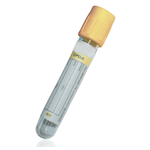Suitable Specimen Types
- Serum
Specimen Transport
.Sample Processing in Laboratory
Usual
.Sample Preparation
Usual
Turnaround Time
7 daysSample Stability
NULL
.IgG4
General Information
IgG subclass assay can be of use in cases of recurrent infection where there is no overt immunoglobulin deficiency. IgG 1 deficiency occurs mostly in combination with defects in synthesis of other immunoglobulin isotypes. IgG 2 deficiency is the main form of IgG subclass defect in children whilst IgG 3 deficiency becomes more common after puberty. IgG 4 deficiency can occur in isolation but this is extremely rare, it most often occurs in combination with IgG 2 deficiency.
Deficiencies in one or other subclass are often masked by a compensatory increase in the other subclasses.
Patient Preparation
None
Notes
This assay is only available on serum.
Reference Range
Age related reference ranges ( all values in g/L):-
Cord Blood IgG1=3.6-8.4, IgG2=1.2-4.0, IgG3 = 0.3-1.5, IgG4 = <0.5
6 months IgG1=1.5-3.0, IgG2= 0.3-0.5, IgG3 = 0.1-0.6, IgG4= <0.5
2 years IgG1= 2.3-5.8, IgG2= 0.3-3.9, IgG3= 0.1-0.8, IgG4 = <0.5
5 years IgG1= 2.3-6.4, IgG2= 0.7-4.5, IgG3= 0.1-1.1, IgG4 = <0.8
10 years IgG1= 3.6-7.3, IgG2= 1.4-4.5, IgG3= 0.3-1.1, IgG4 = <1.0
15 years IgG1= 3.8-7.7, IgG2= 1.3-4.6, IgG3= 0.2-1.2, IgG4 = <1.1
Adult IgG1=3.2-10.2, IgG2= 1.2-6.6, IgG3= 0.2-1.9, IgG4 = <1.3
Specifications
- EQA Scheme?: Yes
-
EQA Status:
NEQAS eqa scheme
